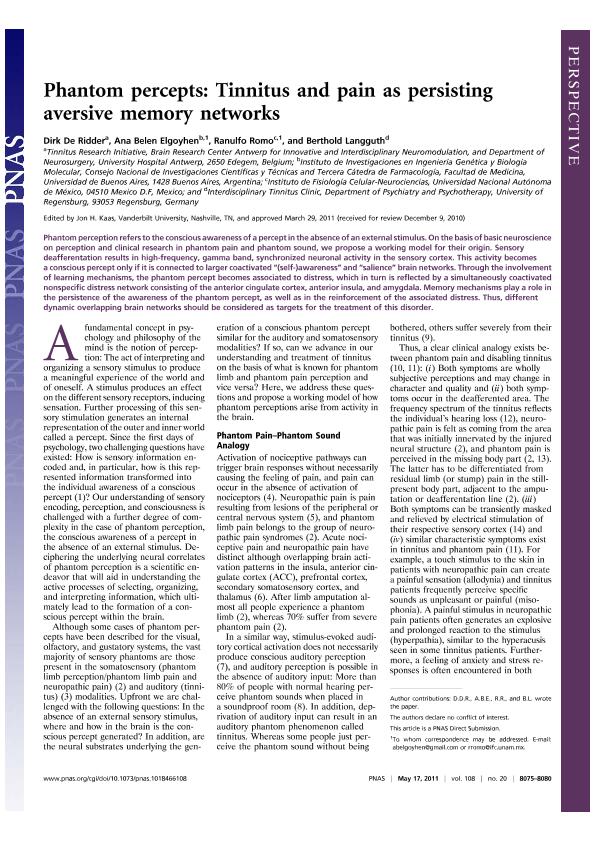Mostrar el registro sencillo del ítem
dc.contributor.author
De Ridder, Dirk
dc.contributor.author
Elgoyhen, Ana Belen

dc.contributor.author
Romo, Ranulfo
dc.contributor.author
Langguth, Berthold
dc.date.available
2019-07-11T20:50:50Z
dc.date.issued
2011-05
dc.identifier.citation
De Ridder, Dirk; Elgoyhen, Ana Belen; Romo, Ranulfo; Langguth, Berthold; Phantom percepts: Tinnitus and pain as persisting aversive memory networks; National Academy of Sciences; Proceedings of the National Academy of Sciences of The United States of America; 108; 20; 5-2011; 8075-8080
dc.identifier.issn
0027-8424
dc.identifier.uri
http://hdl.handle.net/11336/79433
dc.description.abstract
Phantomperception refers to the conscious awareness of a percept in the absence of an external stimulus. On the basis of basic neuroscience on perception and clinical research in phantom pain and phantom sound, we propose a working model for their origin. Sensory deafferentation results in high-frequency, gamma band, synchronized neuronal activity in the sensory cortex. This activity becomes a conscious percept only if it is connected to larger coactivated "(self-)awareness" and "salience" brain networks. Through the involvement of learning mechanisms, the phantom percept becomes associated to distress, which in turn is reflected by a simultaneously coactivated nonspecific distress network consisting of the anterior cingulate cortex, anterior insula, and amygdala. Memory mechanisms play a role in the persistence of the awareness of the phantom percept, as well as in the reinforcement of the associated distress. Thus, different dynamic overlapping brain networks should be considered as targets for the treatment of this disorder.
dc.format
application/pdf
dc.language.iso
eng
dc.publisher
National Academy of Sciences

dc.rights
info:eu-repo/semantics/openAccess
dc.rights.uri
https://creativecommons.org/licenses/by-nc-sa/2.5/ar/
dc.subject
Tinnitus
dc.subject
Perception
dc.subject
Phantoms
dc.subject
Pain
dc.subject.classification
Medicina Critica y de Emergencia

dc.subject.classification
Medicina Clínica

dc.subject.classification
CIENCIAS MÉDICAS Y DE LA SALUD

dc.title
Phantom percepts: Tinnitus and pain as persisting aversive memory networks
dc.type
info:eu-repo/semantics/article
dc.type
info:ar-repo/semantics/artículo
dc.type
info:eu-repo/semantics/publishedVersion
dc.date.updated
2019-07-10T19:04:20Z
dc.journal.volume
108
dc.journal.number
20
dc.journal.pagination
8075-8080
dc.journal.pais
Estados Unidos

dc.journal.ciudad
Washington
dc.description.fil
Fil: De Ridder, Dirk. University Hospital Antwerp; Bélgica
dc.description.fil
Fil: Elgoyhen, Ana Belen. Consejo Nacional de Investigaciones Científicas y Técnicas. Instituto de Investigaciones en Ingeniería Genética y Biología Molecular "Dr. Héctor N. Torres"; Argentina. Universidad de Buenos Aires. Facultad de Medicina; Argentina
dc.description.fil
Fil: Romo, Ranulfo. Universidad Nacional Autónoma de México; México
dc.description.fil
Fil: Langguth, Berthold. Universitat Regensburg; Alemania
dc.journal.title
Proceedings of the National Academy of Sciences of The United States of America

dc.relation.alternativeid
info:eu-repo/semantics/altIdentifier/doi/http://dx.doi.org/10.1073/pnas.1018466108
dc.relation.alternativeid
info:eu-repo/semantics/altIdentifier/url/https://www.pnas.org/content/108/20/8075
Archivos asociados
